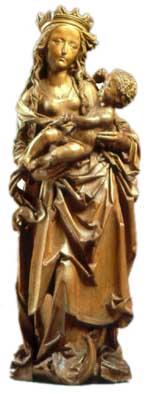
Any minor impressionist is better known to today’s public than Tilman Riemenschneider (ca. 1460-1531), one of the greatest artists of the late Middle Ages. There are some obvious reasons for the oversight: Collectors have not stocked American museums with German art, and for many people, the celebration of individual artists begins with the Renaissance. Even so, the fame game in art history often seems utterly absurd. On the way to the current Riemenschneider show at the Metropolitan Museum of Art, you will pass some sculptures by that celebrity and popular favorite Rodin. Rodin may be one of my blind spots, but I found the contrast between the two sculptors painfully telling. How could anyone fail to conclude that compared with Riemenschneider, Rodin is a cloddish show-off?
It speaks well of the Met and the National Gallery in Washington that they would jointly organize Tilman Riemenschneider: Master Sculptor of the Late Middle Ages, a show that’s not an obvious crowd-pleaser. It speaks well of the audience too. I watched the surprising numbers of people in the galleries, and they seemed to take their time, studying the subtleties of the work with a kind of slow relish. This is one of the glories of New York – that there remain so many different crowds here, including an appreciative audience for work of sublime, brilliantly expressed religious feeling. In this show, there are about 60 pieces, many of them once part of larger ensembles; they are made from materials as diverse as lime wood, sandstone, and alabaster. Riemenschneider’s virtuosity is made transparently clear in the opening room, where the curators juxtapose two alabaster Annunciations, one by Riemenschneider and the other by a lesser artist. The flowing, sweetly composed lines of the Riemenschneider seem to give his light-filled stone the breath of life. The other work seems static, if prettily so.
Riemenschneider spent most of his life in Würzburg, where he ran a successful workshop that created sculpture for the churches of the region; he also made smaller works for private devotion. His life probably ended badly – perhaps with torture – when he opposed the prince-bishop of Würzburg during the Peasants’ Revolt of 1525. A contemporary of Dürer, Riemenschneider drew upon a highly sophisticated and vital tradition; he probably looked to such great Netherlandish masters as Roger van der Weyden and to the many strong sculptors working in the region. (The show includes art by predecessors and contemporaries such as Niclaus Gerhaert von Leiden.) The religion of the time was marked by gentle, melancholic piety, in which worshipers contemplated the lives of the great figures of Christianity as part of their practice. Riemenschneider therefore imbued his materials with a vivid and pleasing sensation of living flesh, which helped viewers identify with, say, the Virgin. At the same time, he brought an air of the detached and abstract to his work, through the careful way he composed the folds of the drapery, stretched out the figures, and played line against volume. As a result, aesthetic and religious reverie come together in Riemenschneider’s art, each enhancing the other.
Riemenschneider had an unfailing ability to locate the exacting edge between the physical and the spiritual. His people are at once down to earth and elevated, of the moment and eternal. They can be reached but not possessed. In Riemenschneider’s art, there is something reminiscent of a candle. His figures are elongated and vertical; as they rise, they retain their hefty presence. Yet the spiraling of the lines and the sweep of the shapes strongly evoke the flickering of flame – and the way smoke twists upward. The body becomes transcendent.